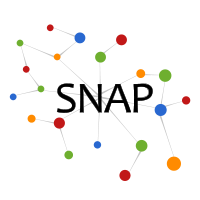Dynamic Face-to-Face Interaction Networks
Dataset information
The dynamic face-to-face interaction networks represent the interactions that happen during discussions between a group of participants playing the Resistance game. This dataset contains networks extracted from 62 games. Each game is played by 5-8 participants and lasts between 45--60 minutes. We extract dynamically evolving networks from the free-form discussions using the ICAF algorithm. The extracted networks are used to characterize and detect group deceptive behavior using the DeceptionRank algorithm.
The networks are weighted, directed and temporal. Each node represents a participant. At each 1/3 second, a directed edge from node u to v is weighted by the probability of participant u looking at participant v or the laptop. Additionally, we also provide a binary version where an edge from u to v indicates participant u looks at participant v (or the laptop).
Project website with demo: Please refer to the project website for details about the network extraction algorithm and to visualize the networks.
| Dataset statistics | |
|---|---|
| Number of networks | 62 |
| Number of nodes | 451 |
| Number of edges | 3,126,993 |
| Average number of edges per network | 50,435 |
| Total temporal length | 142,005 seconds |
| Average temporal length per network | 2,290 seconds |
Source (citation)
- S. Kumar, C.Bai, V.S. Subrahmanian, J. Leskovec. Deception Detection in Group Video Conversations using Dynamic Interaction Networks. 15th International AAAI Conference on Web and Social Media (ICWSM), 2021.
- C.Bai, S. Kumar, J. Leskovec, M. Metzger, J.F. Nunamaker, V.S. Subrahmanian. Predicting Visual Focus of Attention in Multi-person Discussion Videos. International Joint Conference on Artificial Intelligence (IJCAI), 2019.
@inproceedings{kumar2021deception,
title={Deception Detection in Group Video Conversations using Dynamic Interaction Networks},
author={Kumar, Srijan and Bai, Chongyang and Subrahmanian, VS, and Leskovec, Jure},
booktitle={ICWSM 2021},
year={2021},
organization={International AAAI Conference on Web and Social Media}
}
@inproceedings{bai2019predicting,
title={Predicting the Visual Focus of Attention in Multi-Person Discussion Videos},
author={Bai, Chongyang and Kumar, Srijan and Leskovec, Jure and Metzger, Miriam and Nunamaker, Jay and Subrahmanian, VS},
booktitle={IJCAI 2019},
year={2019},
organization={International Joint Conferences on Artificial Intelligence}
}
Files (Download)
| File | Description |
|---|---|
| network_list.csv | List of network ID and number of participants |
| network/network[ID].csv | Dynamic face-to-face interaction networks. One file per network. |
| network/network[ID]_weighted.csv | Weighted version of dynamic face-to-face interaction networks. One file per network. |
| network_loader.py | Code to easily load the data. |
Data format
network_list.csv: Each network ID represents one discussion.0,7
1,8
where
- NETWORK: Network ID.
- NUMBER_OF_PARTICIPANTS: The number of participants in the network.
For files network/network[ID].csv: One file per game. Each file has the time series of the who-looks-at-whom networks. Each row is a binary adjacency matrix. For example, in network0.csv:
0.0,0,0,0,0,1,0,0,1,0,0,0,0,0,0,0,0,0,0,0,0,0,0,1,0,0,0,0,0,0,0,1,0,0,0,0,0,0,1,0,0,0,0,1,0,0,0,0,1,0,0,0,0,0,0,0,0,0,0,1,0,0,0,0
where, in each row:
- TIME: Timestamp of the current row's adjacency matrix. Each timestamp represents 1/3 second
- Pi_TO_*: binary variables indicating where participant i is looking at in the current timestamp. The options are the other participants and the laptop in front. As a participant can look at only one entity a given timestamp (i.e., outdegree = 1), so only one of her binary variables is 1. For each participant Pi, we have the following variables:
- Pi_TO_Pj: binary variable indicating if participant i looks at participant j at the current timestamp. (Pi_TO_Pi is by default 0.)
- Pi_TO_LAPTOP: binary variable indicating if participant i looks at her laptop.
For files network/network[ID]_weighted.csv: One file per game. This is a weighted version of the binary adjacency matrices. Each file has the time series of the weighted who-looks-at-whom networks. Each row is a weighted adjacency matrix. For example, in network0_weighted.csv:
0.0,0.016,0.0,0.0,0.0,0.572,0.0,0.0,0.534,0.0,0.046,0.083,0.0,0.041,0.029,0.067,0.077,0.023,0.0,0.127,0.011,0.025,0.034,0.503,0.079,0.03,0.041,0.0,0.039,0.041,0.037,0.533,0.1,0.049,0.019,0.063,0.0,0.073,0.377,0.12,0.043,0.034,0.04,0.357,0.02,0.0,0.05,0.256,0.15,0.111,0.131,0.128,0.044,0.115,0.0,0.12,0.094,0.071,0.136,0.172,0.053,0.165,0.109,0.0
where in each row:
- TIME: Timestamp of the current row's adjacency matrix. Each timestamp represents 1/3 second
- Pi_TO_*: Variables indicating the weight of where participant i is looking at in the current timestamp (higher weight means higher likelihood of looking). The options are the other participants and the laptop in front. The sum of all outgoing edge weights (towards other participants and the laptop) for each participant is 1. For each participant Pi, we have the following variables:
- Pi_TO_Pj: Variable indicating the weight of participant i looking at participant j. Pi_TO_Pi is by default 0.
- Pi_TO_LAPTOP: Variable indicating the weight of participant i looking at her laptop.



